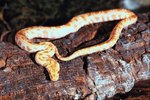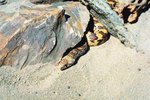
Prairie king snakes (Lampropeltis calligaster calligaster) are medium-sized, non-venomous colubrids native to the grasslands and open forests of the south-central United States. Though dangerous predators of snakes, lizards and rodents in their own right, prairie king snakes face pressure from predators like red-tailed hawks (Buteo jamaicanensis). Additionally, humans and their cars are significant dangers for these snakes.
Birds of Prey
Birds of prey are significant predators of snakes anywhere that the two coexist. Red-tailed hawks are well documented ophidiophages, or snake eaters, that scan the ground for prey with incredible vision. One of the ways that prairie king snakes defend themselves from hawks is by remaining hidden; in a 1978 study of prairie king snake natural behavior, iconic herpetologist Henry S. Fitch noted that the species was invariably found under cover of some sort. In addition to red-tailed hawks, great horned owls (Bubo virginianus) are documented predators of the snakes as well.
Carnivorous Mammals
A number of carnivorous mammals within the range of the prairie king snake opportunistically consume snakes. Notable examples include striped skunks (Mephitis mephitis), Virginia opossums (Didelphis virginiana) and raccoons (Procyon lotor). Prairie king snakes, like many species of snake, will expel a foul-smelling musk to deter predators; as birds typically have a poor sense of smell, musk has likely evolved in response to mammalian predators. Encounters with these animals are generally at night, as prairie king snakes are typically nocturnal, like these predators.
Larger King Snakes
Prairie king snakes are consumed by larger prairie king snakes and sympatric subspecies of the common king snake (Lampropeltis getula ssp.). Spending much of their time underground, prairie king snakes are uniquely vulnerable to other snakes. While burrows may protect the snakes from mammals and birds, other snakes are well suited to hunt in these subterranean retreats. King snakes can consume snakes almost as large as they are, so a small discrepancy in size can mean the difference between being the predator and the prey.
Humans
Humans are harmful to prairie king snakes in three primary ways: directly killing the animals, running them over with cars and destroying their habitat. The effects of habitat destruction on these snakes is difficult to ascertain, as the shy nature of the species makes population surveys difficult. Humans often purposely kill these snakes, presumably mistaking their tail rattling defensive behavior for that of rattlesnakes, despite their generally benign temperament. While road kills are one of the leading causes of snake mortality, roads divide habitats and prevent dispersal, further pressuring wild populations.
References
- Herps of Arkansas: Prairie King Snake (Lampropeltis Calligaster Calligaster)
- Journal of Herpetology: Habitat Use and Activity of Prairie Kingsnakes (Lampropeltis Calligaster Calligaster) in Illinois
- Proceedings Arkansas Academy of Science: A One-year Study of the Species Diversity and Relative Abundance of Snakes and Lizards in the Jack Mountain Region of Hot Spring County, Arkansas
- Kansas Herpetofaunal Atlas: Prairie Kingsnake
- US Geological Survey: Red-Tailed Hawk Predation on Snakes: The Effects of Weather and Snake Activity
- Transactions of the Kansas Academy of Science: A Field Study of the Prairie Kingsnake
- Wild Skunk Rescue: About Skunks
Photo Credits
-
Jupiterimages/Photos.com/Getty Images




